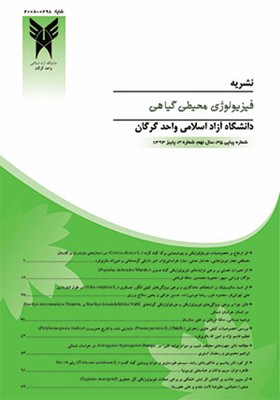مطالعه پاسخ دفاعی و بیوشیمیایی گوجهفرنگی در شرایط آلودگی به گیاه انگلی سس زراعی (Cuscuta campestris Yunck.)
محورهای موضوعی : ژنتیکآسیه سیاهمرگویی 1 * , فاختک طلیعی 2 , مهتاب یزدان دوست 3
1 - گروه زراعت، دانشکده تولید گیاهی، دانشگاه علوم کشاورزی و منابع طبیعی گرگان، گرگان، ایران.
2 - گروه تولیدات گیاهی، دانشکده کشاورزی و منابع طبیعی، دانشگاه گنبد کاووس، گنبد کاووس، ایران.
3 - گروه زراعت و اصلاح نباتات، واحد گرگان، دانشگاه آزاد اسلامی، گرگان، ایران.
کلید واژه: مقاومت, رقم, آنزیم, گوجه فرنگی, آنتی اکسیدان, سس,
چکیده مقاله :
سس (Cuscuta campestris Yunck.) یکی از علفهای هرز مهم انگلی در جهان است. آلودگی به سس باعث کاهش عملکرد محصول و افزایش هزینه های برداشت می شود. ﺑﺮای ﻛﻨﺘﺮل ﻋﻠﻒﻫﺎی ﻫﺮز اﻧﮕلی روشهای ﻣﺨﺘﻠﻔﻲ پیشنهاد ﺷﺪه اﺳـﺖ؛ اما هیچکدام قادر به کنترل موثر این گیاه نیستند. به نظر میرسد استفاده از ارقام مقاوم بهترین گزینه برای دستیابی به این هدف است. در این تحقیق مقاومت 15 رقم گوجهفرنگی به آلودگی سس در شرایط گلخانه مورد بررسی قرار گرفت. از بین این ارقام، دو رقم حساس و مقاوم (به ترتیب سوپراوربانا111 و سوپر چف) انتخاب و میزان فعالیت آنزیم های کاتالاز، گایاکول پراکسیداز، آسکوربات پراکسیداز و همچنین مقدار فنل کل، پرولین، فلاوونویید و قندهای محلول در زمانهای مختلف پس از آلودگی (صفر، 24، 48، 72، 96، 120 و 240 ساعت) مورد بررسی قرار گرفت. نتایج نشان داد که آلودگی به سس زراعی باعث افزایش غلظت آنزیم ها (کاتالاز، گایاکول پراکسیداز، آسکوربات پراکسیداز) در مقایسه با تیمار بدون آلودگی می شود. همچنین مقدار این آنزیمها در رقم مقاوم بیشتر از رقم حساس بود. رقم و زمان نمونه برداری، میزان فنل کل، پرولین، فلاوونوییدها و قندهای محلول را تحت تاثیر قرار داد. میزان فنل کل و فلاوونویید پس از اتصال سس به گوجهفرنگی افزایش یافت و در 240 ساعت پس از اتصال به بیشترین مقدار خود رسید. نتایج این تحقیق نشان میدهد که آلودگی گوجه فرنگی به سس زراعی سبب القای سیستم دفاعی در این گیاه میشود. با توجه اینکه امکان کنترل کامل گیاهان انگلی بدون آسیب به گیاه زراعی وجود ندارد، شناخت مکانیسمهایی دفاعی که با استفاده از آن، ارقام مقاوم در مقابل گیاهان انگلی ایستادگی می کنند، می تواند بسیار کاربردی و مفید باشد.
Dodder is a one of the major parasitic weeds in the world. Dodder infestations reduce crop yield and increase harvesting costs. Different methods have been suggested to control of dodder, but none of them have been able to control these plants reliably. It seems that using resistant varieties is the best option to achieve this goal. In this study, resistance of 15 varieties of tomato to dodder infection (Cuscuta campestris Yunck.) were investigated under greenhouse conditions. Among these varieties, two susceptible and resistant varieties (Supra Urbana and Super Chef, respectively) were selected and catalase, guaiacol peroxidase, ascorbate peroxidase, total phenolic compound, proline, flavonoid and soluble sugars was evaluated at different times after infection (0, 24, 48, 72, 96, 120 and 240 Hours). The results showed that dodder infection increased the enzymes concentration (catalase, guaiacol peroxidase, ascorbate peroxidase) compared to the non- infection treatment. Also, the amount of these enzymes in resistant cultivar were higher than susceptible cultivar. Variety and sampling time affected on total phenol content, proline, flavonoids and soluble sugars. Total phenolic compound and flavonoid levels increased after attaching the dodder to the tomato and reached its highest level at 240 h after attachment. This results indicates the induction antioxidant defence system in tomato under dodder infection. The results of this study show that contamination of tomato with dodder induces the immune system in this plant. Given that it is not possible to perfect control of parasitic weeds without crop damage, it can be very useful to know the defence mechanisms by which cultivars resistant to parasitic plants stand.

